PPC
How Long Should a Blog Post Be in 2023? 3 Rules to Live By

So: you want to write a blog post. Allow me to be the first to congratulate you. Writing may be one of the biggest boondoggles on the planet. It’s fun, can be cathartic, and when done well/correctly, it can pay some serious dividends for you, and for your business.
How do I know? I’ve penned a few blog posts in my day. Some of them get tens of thousands of reads each month (humblebrag). I say this not to toot my own horn, but to tell you that I am uniquely situated to give advice on how long your blog post should be.
Want the quick answer? Like most things, it depends.
I know. I hate that answer too. But it’s true. Get a solid grasp on your use case, and combine it with the rules I’m about to talk about, and I promise that by the end of this post, you’ll have a pretty damn good idea how long your blog post should be.
And because we’re is all about helping business owners succeed through smart digital marketing, we are going to frame this discussion through precisely that lens: the marketer or business owner who is leveraging blogging as part of a broader content marketing strategy to drive traffic, scale leads, and grow revenue.
But hey, even if that’s not you: I have a feeling you’ll get some value out of this post anyway.
How long should a blog post be? What the data says
If you’ve spent some time combing through search results looking for the answer to this question, you’ve probably seen that the results are mixed. Here are some answers from the top results:
- 1,500-2,000 words
- 3,000+ words
- 2,100-2,400 words
- 300-600 words
Basically, the internet says a good blog post is anywhere from 300-3,000+ words long. That’s not exactly a helpful range.
To get a more data-supported range, we looked at our top 10 posts from the last year and from the last three years. We found our best-performing blog posts average 2,700-3,000 words.
That’s a little more direct of an answer, but it doesn’t take into account many factors that should influence your blog post length. That’s where these rules come in…
3 rules to determine how long your blog post should be
Here are my top three hard-and-fast rules to live by if you want to write a blog post that gives your business the shine and visibility it deserves.
Rule #1: When in doubt, make it long
You heard it here first: length is not everything. And we’re going to talk precisely about why length is not everything in the sections to come. But as a general rule to live by, deep, long-form content is the content that readers like.
Why? Because generally speaking, length equates to value. And–highlight this next point as furiously as you can–the thing search engines care about the absolute most is how much value, on average, readers are getting out of your blog post.
So if, like marketing guru Seth Godin, you already have millions of readers subscribed to your short-form newsletter, or if you’re writing a blog post with a goal of repurposing it on LinkedIn, by all means, keep it short and sweet.
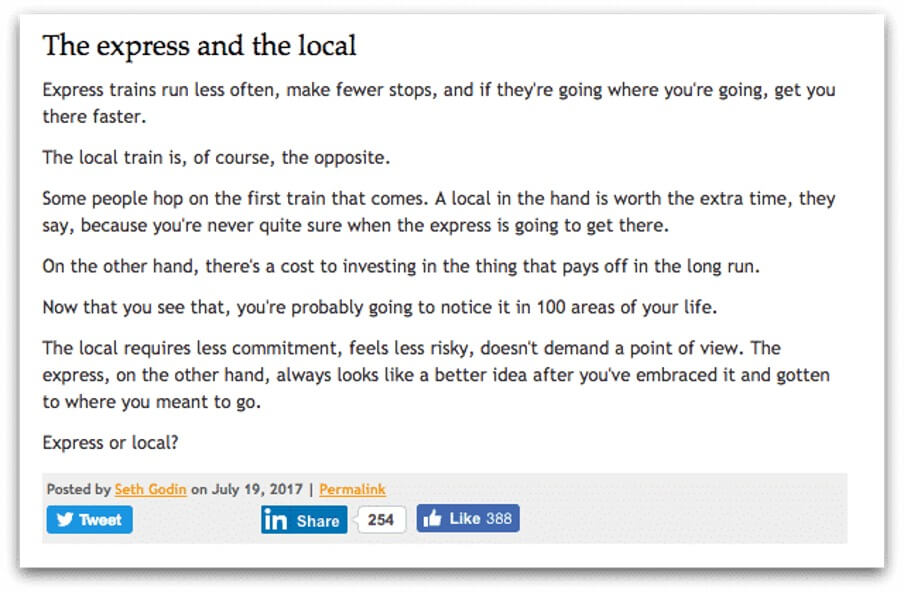
But if you’re writing a blog post with the intent of rocketing to the top of Google’s search results, and driving thousands of free eyeballs to your website? Then you need to talk at length, and go deep, on your subject.
I’m not talking about being wordy for the sake of writing a long blog post. I’m talking about giving useful examples, giving a thorough explanation of concepts, and attacking your topic in a way that will leave readers thinking: Damn, that was comprehensive AF.
If you’ve already written a bunch of long-form content for your website, I know what you’re probably thinking: Man, I haven’t really written at length on enough of these topics. That’s okay. Because you already have the scaffolding of a great blog post. All you have to do is beef it up.
If the person I’m describing is you, here’s a quick pro tip: any SEO software worth its weight in gold (think: Ahrefs, SEMrush, Moz) is going to have an audit tool that surfaces thin content for you. Thin content is just that: there are not enough words on the page to meet the requirements for true topical expertise.
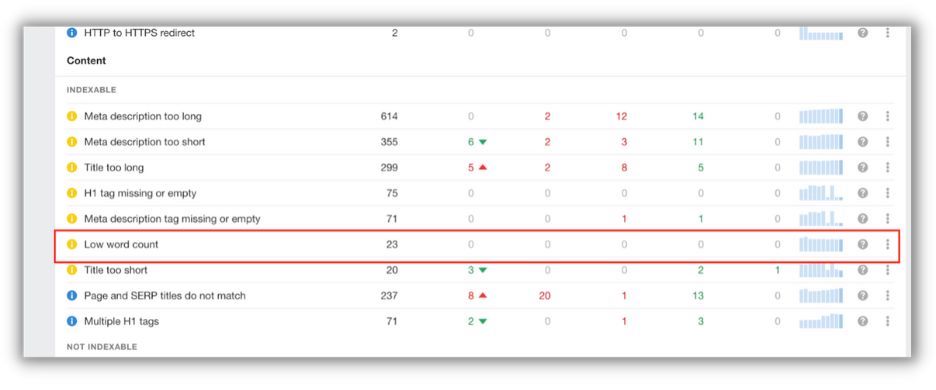
You can use reports like these to discern where it’s necessary to write more. Or, you can simply audit your existing content manually and give yourself an honest assessment: how often am I truly going deep on the topics my readers or customers care about?
Rule #2: Above all, deliver value
This easily could have been our first rule, because it’s probably the most important. But I think it’s useful to talk about value through the lens of length, because length is really critical as a component of SEO-driven content marketing.
But guess what? As I said in the first section: length is not everything. And where length fails, you’ll almost always find that it’s because the piece did not deliver enough value.
Let me explain: Google and Microsoft have hundreds of factors they look at every day when determining the order in which they rank content. We call these things ranking signals (or factors).
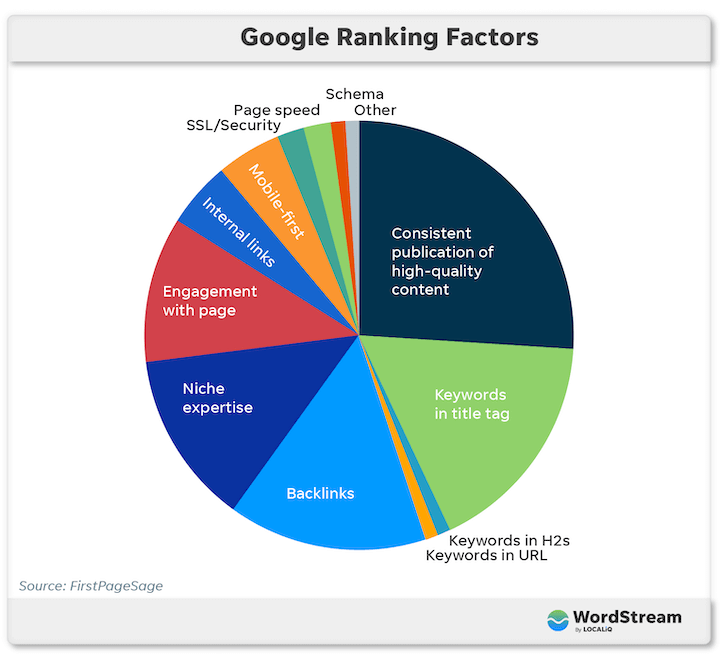
See that big red slice of the pie? That’s page engagement. When Google is assessing how valuable or not valuable your blog is to a user, it’s primarily looking at how effective your blog is at getting the reader to engage.
The critical metric to look at here? Dwell time. You can think about how long a user spends on your page, on average, as one of the strongest indicators of whether your blog post has delivered value.
Dwell time is not going to show up in your Google Analytics reports. However, Average Session Duration is, and it is a great metric for keeping tabs on how long your readers are spending on your blog posts. Or, if you’re using Google Analytics 4, which we all will be soon, you can use Average Engagement Time.
Other engagement metrics, like Engaged Sessions (the number of sessions that lasted longer than 10 seconds, or had a conversion event, or had 2 or more screen or page views), and Engagement Rate (number of Engaged Sessions divided by total sessions) are also really strong proxies for traffic quality and are readily available to you in GA4.
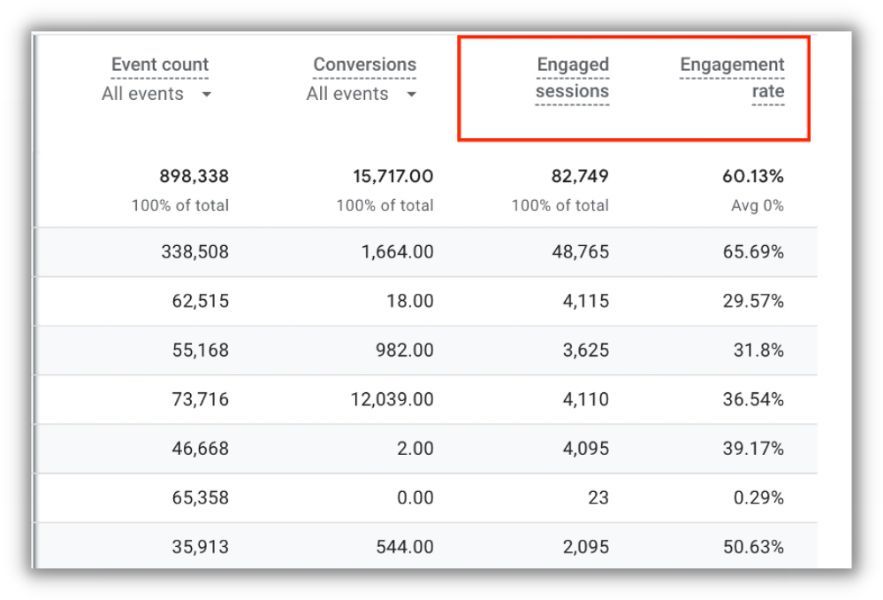
How do you increase dwell time? Well, it stands to reason that the higher your word count, the longer the reader should stay on the page. But what if your lengthy blog post isn’t saying much of anything at all? Then you’re going to have a difficult time outranking your competitor. Even if they wrote 500 words and you wrote 1,500.
Consider how big of an impact images, videos, infographics, and other visual examples can make on how long you, personally, spend reading a blog post. Deep concepts will always increase dwell time, because they force readers to evaluate what you’re writing about, and how to apply it to themselves. It’s not all just window dressing.
But if you can combine deep concepts with compelling visuals that lend context to the text and enhance the value your reader is getting out of the post? Then you’re really cooking with gas.
Rule #3: Do your research
Man, it’s quite possible that not one of these rules is more important than another! Because you can’t really live by the first two rules without taking rule #3 into account.
Let’s go back to what I said in the introduction about context. About knowing your situation, your niche, your competition, and above all, what you’re trying to accomplish with your blog post.
78% of marketers identify keyword research as a high-impact practice for driving new traffic.
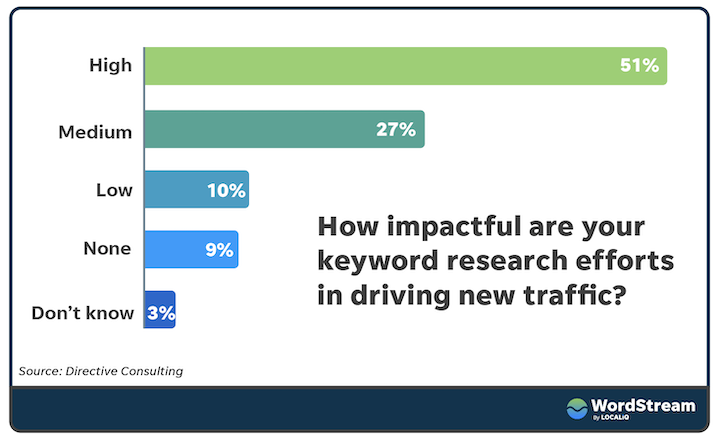
But the purpose behind keyword research goes beyond simply optimizing your H1s and H2s. If you want to know exactly how long to make your blog post, look no further than the keyword you’re trying to rank for.
Let’s look at an example. Let’s say you’re a roofing company. You’ve been running search ads targeting prospects who are looking for roofing services, but you want to start driving organic traffic from people who are more in the “consideration” phase of the buying process.
You use your favorite keyword research tool, and find that the keyword “how to install metal roofing over shingles” has some nice search volume. The intent is exactly what you’re looking for: this person is probably considering the DIY route, but with some education, which your blog post will provide, you can convince them that metal roofing is a job best left to professionals (i.e. you).
How long should your blog post be? Well, you can simply enter the query into Google, copy and paste the text from the top three ranking blog posts into a word counter, average them out, and write a post that exceeds that number. Or you can use your favorite SEO tool (I’m a fan of Ahrefs) to get all this information at a glance.
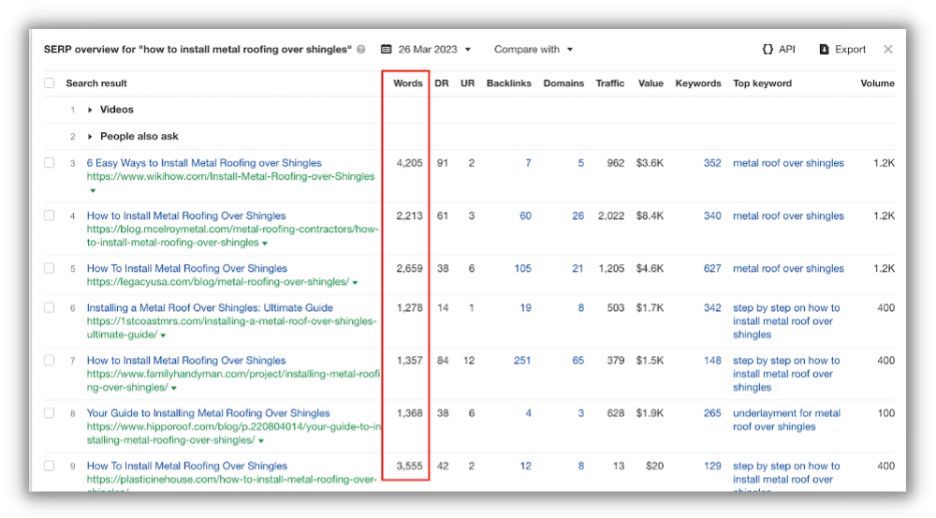
As you can see, the top-ranking post for this query has a whopping 4,205 words. That’s a beast of a post. But even if you want to rank in the top 10, you’re probably looking at a minimum of 1,500 words based on the other posts in this SERP (Search Engine Results Page).
This birds-eye view of the SERP is incredibly useful when determining blog post length, and not just because you’re getting word count totals. You might be saying, Wait a minute, the post in the 7th position only has 1,357 words. How is it outranking the post in the 9th position, which has 3,555 words?
Well, the post in the 7th position has a higher Domain Authority, and more backlinks, which, you guessed it, are two more really critical ranking factors.
Do you have a fairly new website or business, or are you still growing your topical authority? Don’t despair: check out the post in the 6th position. It has the lowest Domain Authority in the bunch, the lowest word count, and a pretty slender backlink profile, and yet it’s still doing pretty well here. How is that possible?
That’s the magic of rule #2 at work. If you can deliver a blog post that truly delights and informs your readers, you give yourself an amazing chance to rank and drive traffic, regardless of all the other factors in play.
Make it long, make it valuable, and do your research!
There you have it! As I mentioned, there are a number of factors that go into determining how long a blog post should be. But you can do a heck of a lot worse than honing in on these three:
- When in doubt, make it long
- Deliver value
- Do your research!
If you can outwrite your competition, deliver more value, and take a research-based approach, I guarantee people will read and love your blog post.
I hope you loved this one! If you have any questions or comments, feel free to hit me up on LinkedIn. Happy writing!
PPC
Low Risk, High Reward YouTube Ads alexking

Do you want to introduce your client to YouTube ads but thought it was too high risk?
Have you thought about diversifying your marketing channels and want to know how to launch on YouTube with minimal risk?
You’re not alone. More and more advertisers have either spotted the potential of YouTube or want to add to their existing profitable channels. Unfortunately a significant number have subsequently retreated after seeing poor initial results.
The lowest risk way to get results with YouTube ads (and possibly the highest return), is with YouTube placement targeting.
By serving your ads on specific YouTube videos or channels that are a perfect match for your product or service, you minimize wasted impressions on an irrelevant audience. In turn you maximize your return on ad spend.
The Pyramid Targeting Technique: A Strategic Framework
As part of my “Pyramid Targeting Technique” model for profitable YouTube ad campaigns, placement targeting sits at the top.
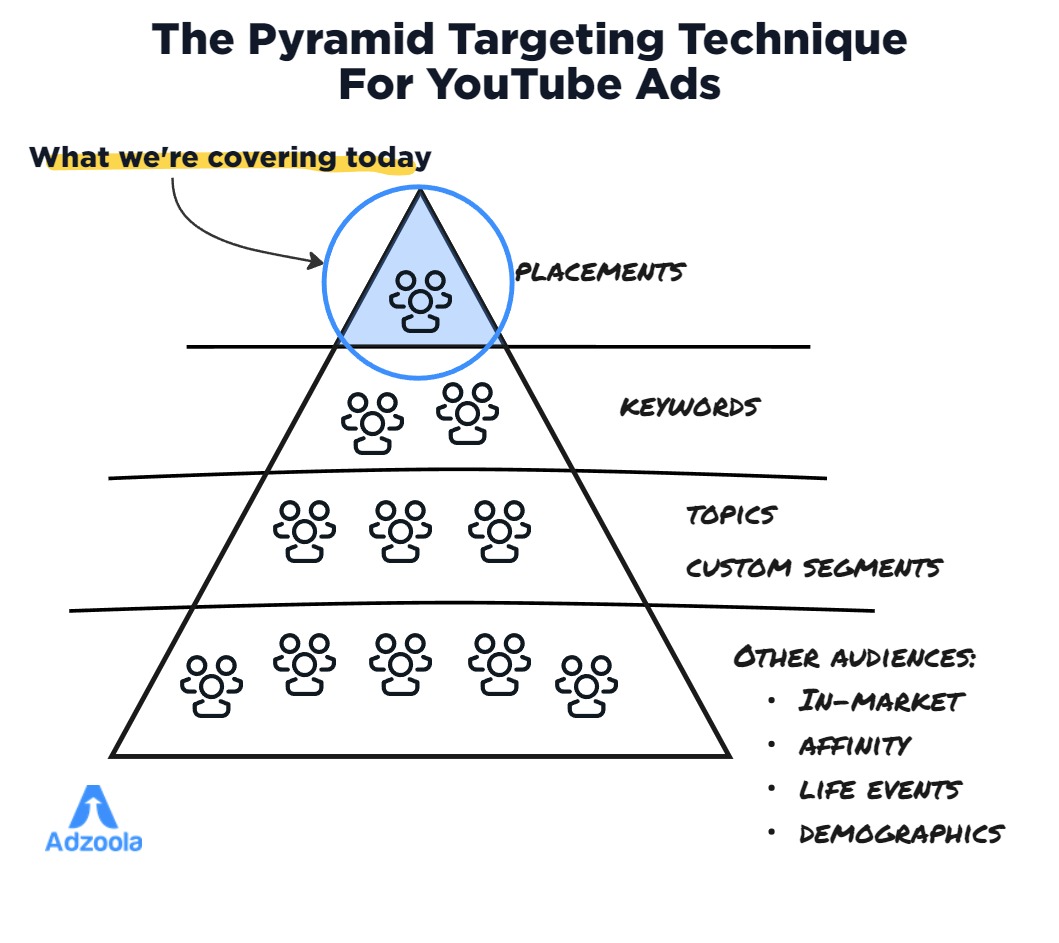
This laser-focused method allows you to hand-pick exactly where your ads will be displayed – giving you unrivaled control.
Here’s why you’ll want to start with YouTube’s placement targeting:
1. Profit-Producing ROI Potential
With tight audience targeting you’re putting your ads directly in front of a highly relevant, interested crowd. This precision-striking ability maximizes your chances of driving conversions by meeting their intent with your message.
2. Small Budget, Big Results
Since you can start with a small number of placements, placement targeting is ideal for affordably testing different ads and messages without blowing your budget. Find your winners first, then scale up (working your way down the pyramid).
3. You’re the Master of Your Audience
You choose the specific videos and channels to run your ads on, rather than relying on Google’s algorithms to figure out relevancy and serve your ads. This granular control helps ensure your ads stay hyper-focused on your prime prospects.
With such a narrow targeting method, audience sizes will naturally be smaller than broader methods like keywords, topics, custom segments and interests. But that’s the advantage – you can consistently put your brand in front of an audience you know have intent and interest at the moment you’re reaching them.
Placement Pitfalls to Avoid & Quick-Fire Tips
Placement targeting isn’t always a magic bullet. Advertisers often struggle with a few common pitfalls that sabotage their results. These will help you avoid being one of those who say “I tried, it doesn’t work” or “It won’t get conversions”.
1. Bidding Too Low
Given placement targeting is the most precise form of targeting on YouTube, it often requires higher bids to effectively compete in the auction. In practice, many advertisers pay less than their maximum bid due to the auction dynamics. Remember, you’re targeting an ultra-focused audience – it’s worth paying for that privilege.
2. Overly Restrictive Layered Targeting
Combining placement targeting with too many additional targeting restrictions, such as narrow age or geographical limits, can overly constrict the audience size and hinder performance. A light touch is often best.
3. Manual Optimization Neglect
Some advertisers struggle with high cost-per-acquisition (CPA) on placement campaigns. Often they haven’t engaged in regular manual optimizations. As it’s a manual campaign you’ve got to review and optimize regularly.
4. Misusing as a Scale Tool
While extremely powerful, placement targeting simply won’t reach the same stratospheric audience levels available on YouTube as broader methods. Use it as an intelligent testing bed and build scale with other targeting methods (further down the pyramid).
5. Keep your video and channel placements in different campaigns for easier management and optimization.
Keep your video and channel placements in different campaigns for easier management and optimization.
6. Mixing Videos and Channels
Keep your video and channel placements in different campaigns for easier management and optimization.
7. Path of Least Resistance
When starting out, it’s often easier to find well-performing individual video level placements rather than channel placements. Build from that base.
Setting Up YouTube Placements
To set up your YouTube ad campaign targeting placements, you’ll start by selecting ‘create a campaign without a Goal’s guidance’, then choose the Video campaign.
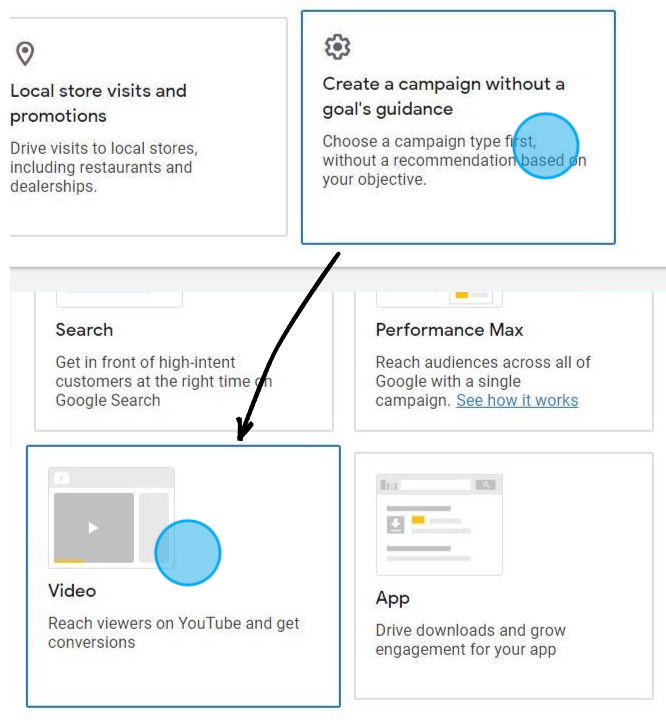
You can use placement targeting (and the other content targeting options) in four video campaign subtypes:
- Video Views – using Max CPV, Target CPV (with Multi-format ads enabled)
- Efficient Reach – using Target CPM
- Non-skippable – using Target CPM
- Audio – using Target CPM
I’d suggest starting with the Video Views Campaign (VVC) subtype if you’re running a direct-response style ad because you can use Maximum CPV (cost per view) bidding.
For in-stream skippable ads, you’ll only pay when someone watches your ad for 30 seconds or more (or watches the full video if it’s less than 30 seconds.) This is saves you money when you’re launching a new client or starting to advertise on YouTube, as it lowers your risk. You’ve chosen specific relevant videos or channels to show your ad on and you only pay when someone chooses not to skip in the first 30 seconds.
So select Video Views as the campaign subtype:
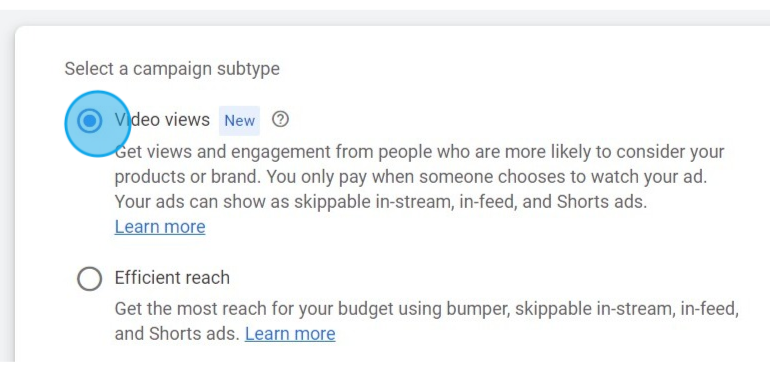
During setup it’s critical that you go to Network settings and uncheck ‘Video partners on the Google Display Network’. It’s easy to forget but it’ll cost you if you do. If you have this checked Google can (and often will) show your video ad on the Display Network, even if you only add placements to your targeting.

Scroll down and you’ll see the Content targeting options – keywords, topics and placements. Select Placements and navigate to ‘Enter’ so you can add your placements.
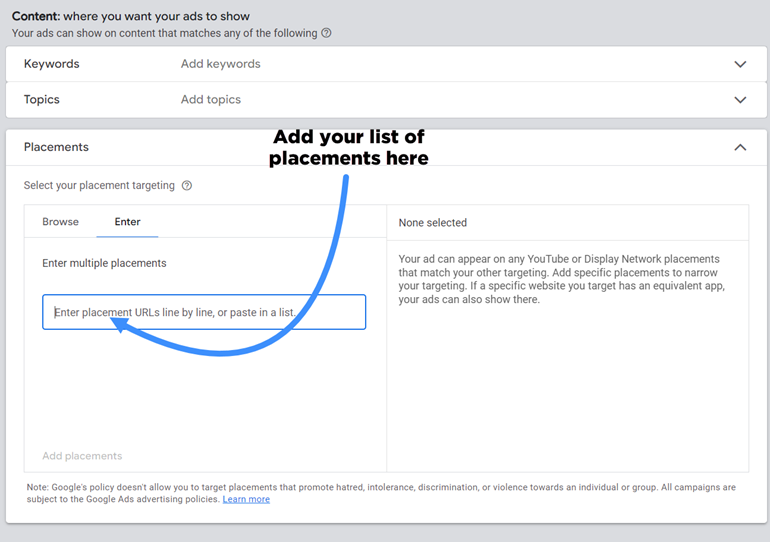
Don’t move on until you’ve actually clicked ‘Add X placements’, otherwise your placements won’t be added. I know it sounds obvious but I’ve seen cases where this has happened. It’s horrible having to tell someone they didn’t actually add the placements and the campaign has been spending that way for a while!
You can use research tools like my own, Adzoola, to find, filter and add video or channel placements to run focused campaigns to a relevant audience.
Test a handful of promising placements, analyze the results, then either maximize the winners or restart your sourcing process.
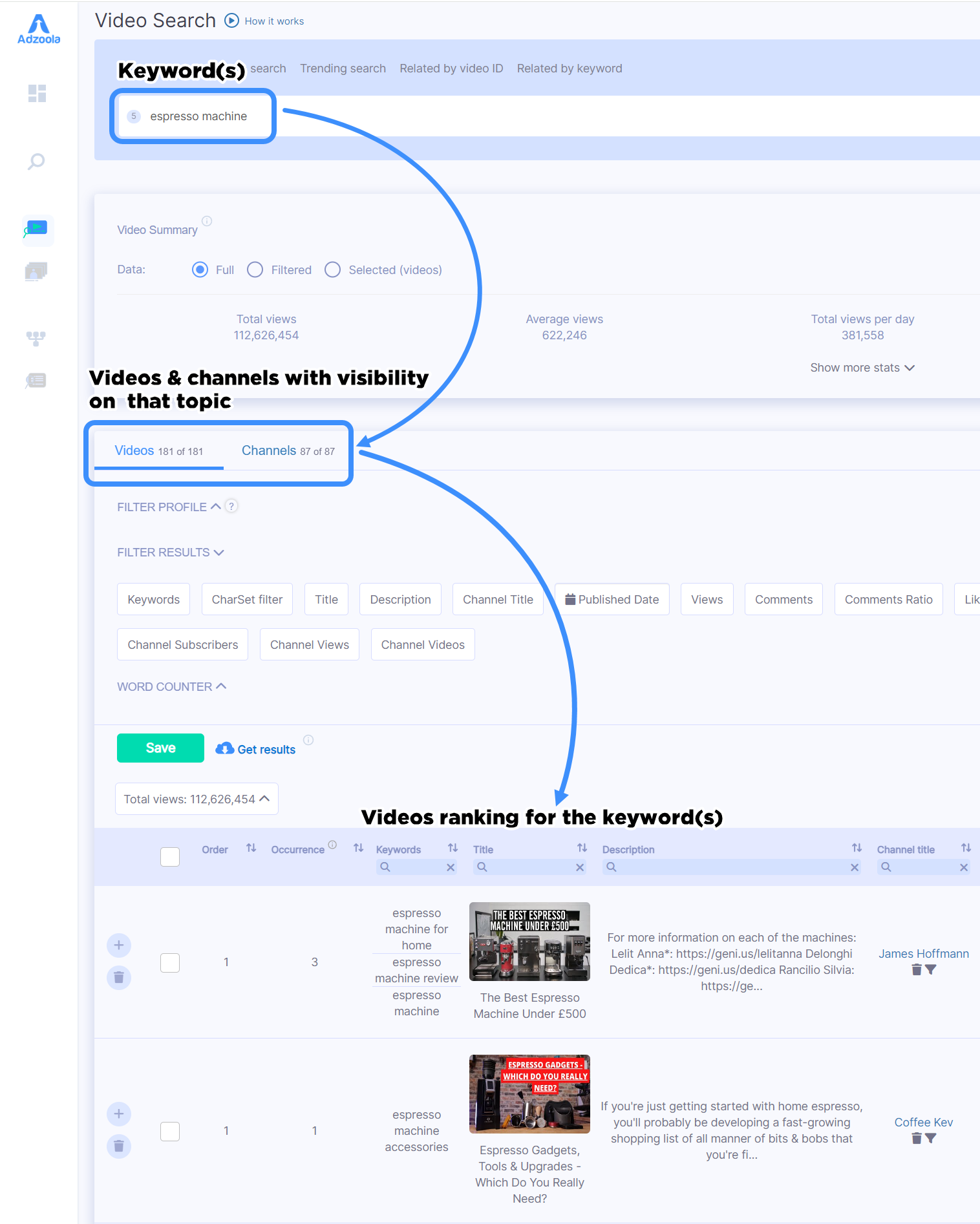
Don’t Sleep on Placements: The Low-Risk Testing Bed
For advertisers looking to maximize ROI from their YouTube ad spend – especially those operating with smaller budgets – placement targeting needs to be a core part of your strategy. The ability to put your brand and messaging in front of an ultra-relevant audience in a cost-effective manner is a game-changing advantage.
While placement targeting may require more manual management than automated campaigns, having that level of hands-on control could be the key to cracking profitable YouTube advertising for your brand and offering.
The Next Level: Scaling Up with the Pyramid
While placement targeting represents the pinnacle of precise YouTube audience targeting, it’s just the first step of a bigger picture strategy.
The Pyramid Targeting Technique is one of the frameworks I teach in my YouTube ads training course to strategically plan, manage, and scale YouTube ad campaigns. It’s designed to guide you along a path to profitable YouTube ads with less risk.
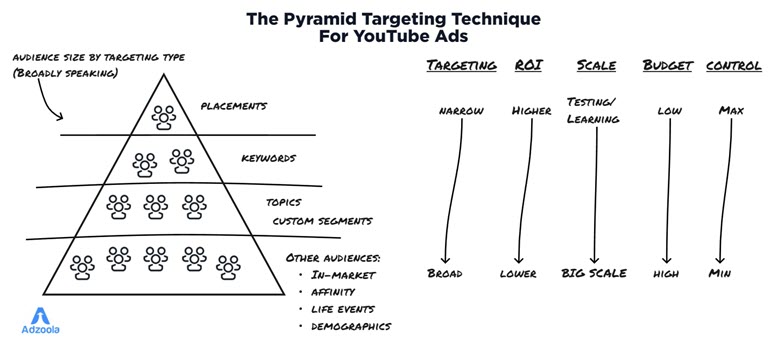
By following the Pyramid Targeting Technique and launching with focused placements, you minimize your upfront risk with lower budgets and maximum control. Once you’ve worked out your winning formula through this testing bed, you can scale your budget and expand targeting incrementally down the pyramid.
And, you can use it at almost any budget level.
If you’re a larger brand with a bigger budget and higher risk tolerance, you can skip levels of the pyramid entirely. Depending on your ability and willingness to go negative on profitability for a period, bigger players can take a more aggressive approach right away.
But for agencies, consultants and small-to-medium businesses, mastering YouTube placement targeting could be the safest and smartest first step for you.
Each successive level down the pyramid represents increased potential scale, but also becomes more hands-off and reliant on Google’s algorithms to optimize targeting. That’s why it’s so crucial for you to get your offering and messaging finely tuned and validated at the more controllable levels like placements first.
The pyramid provides you with a strategic framework to decide the appropriate starting point and level of risk based on your specific circumstances, risk tolerance and ultimate goals. The choice is yours, but this profitable, proven path is clearly mapped for you to follow.
Alex King is the founder of Adzoola and a YouTube ads specialist with over 14 years of media buying experience.
PPC
Google Shopping: A Beginner’s Guide to Crafting a Compelling Campaign Google Shopping: A Beginner’s Guide to Crafting a Compelling Campaign

With all the tools available online, there’s no limit to how you can advertise your eCommerce brand to consumers. With over 12-24 million eCommerce websites across the globe, what matters is how well you leverage these tools to help your business stand out from competitors.
There’s no better way to boost your online presence than with Google, responsible for handling nearly 8.5 billion queries each day. Google’s intuitive marketing tools, such as Google Ads, are trusted by more than 7 million marketers worldwide. If you’re running an eCommerce website, however, you need to be using Google Shopping Ads.
What are Google Shopping Ads?
Launched in 2012, Google Shopping is designed to help online retailers showcase their products visually. If you’ve ever gone looking for a particular item on Google, chances are you’ve come across them at the top of the search results page, lined up horizontally. There’ll be an image, product description, price, and store name. These are Google Shopping Ads.
Google Shopping Ads vs. Google Search
Google Ads and Google Shopping Ads serve different purposes. Google Shopping Ads are essentially product listing ads that help consumers easily learn about a product and where exactly to purchase them. Google Ads (or Google Search Ads) are text-based, relying heavily on copy, while Shopping Ads include images. Google Ads have a much broader scope since you can advertise anything using them, whether they be products or services. Google Shopping Ads can only be used to promote specific products.
The Benefits of Google Shopping Ads
Since Google Shopping Ads are typically displayed at the very top of search results pages, they will be the first thing consumers see when they search for products. This means increased brand visibility for online stores. By the same token, this type of ad can also help retailers reach out to a more specific demographic.
Since Google Shopping Ads collect product information, they can directly target the right audience for your line of business. Studies have also found that Google Shopping Ads achieve 30% higher conversions compared to traditional text-based ads, therefore ensuring better ROI.
4 Ways to Make Google Shopping Ads Work for your Online Business
Having explored the history and advantages of Google Shopping Ads, let’s dive into how you can include them in your eCommerce marketing plan to help you achieve online success:
1. Prioritize Product Feed
When creating Google Shopping Ads for your online store, it is imperative to include key information about your products. Google Shopping Ads highlight product names, images, descriptions, and categories – all of which are vital to your customers being able to find your products easily. For your product titles and descriptions, you may incorporate keywords that can make it a whole lot easier to search for specific items. Using appealing and high-resolution product images can give your website a boost in terms of click-through rates. Don’t forget to include prices.
2. Leverage Customer Reviews
When you look through Google Shopping Ads, you may notice some of them have star ratings. This is because Google allows retailers to display customer reviews in their ads to help promote their products. Studies have found time and time again that 93% of consumers check product reviews before proceeding with their purchases. Posting customer reviews can aid customers in making informed decisions and show them that your brand is trustworthy.
3. Optimize Campaign Structure and Product Groups
To see improve your ROI, you can try optimizing your campaign structure. This helps you manage your campaigns easily since it involves organizing certain aspects of your business such as product types and target customers. Organizing your products by categories can also help the Google algorithm accurately find the right items shoppers are looking for.
All you have to do is simply create different ad groups for different products. For example, if you’re running a clothing store, you can make a specific ad group solely for a specific kind of pants and aim them toward shoppers who are in need of this particular product. This will help your ads drive higher conversion rates and sales since they will only be seen by those who are interested in them.
4. Add Negative Keywords
As with search, one of the many features included in Google Shopping Ads involves the use of negative keywords. Negative keywords are phrases that prevent search algorithms from displaying results that are unrelated or irrelevant to what people are actually looking for. This feature increases search accuracy and makes it way easier for shoppers to find your products.
5. Categorize Ads By Demographics
Whether you wish to expand your reach or target a specific audience, it would be wise to organize your ads according to demographics. Collect pertinent customer data such as location, gender, age, shopping habits, interests, and frequent searches – this information can help you best determine what type of ads your audience will be inclined to engage with. Once you have these details, you can effortlessly target your ideal audience and promote your products among them.
6. Adjust your Bidding Strategy
Since you’re investing resources into creating your ads, it’s important to determine how much you’re actually willing to pay for them. If you’re able to maximize your Google Ads bidding strategies, you can help your brand rank better in search results. Here are some of the popular bidding strategies you can give a try:
- Target Cost Per Action (CPA) – for improving conversions by targeting a specific CPA
- Target Return On Ad Spend (ROAS) – for improving conversions by targeting a specific ROAS
- Maximize Conversion Value – for optimizing conversion value without targeting ROAS
- Maximize Conversions -or optimizing conversion value without targeting CPA
- Maximize Enhanced Cost Per Click (ECPC) – for automatically adjusting manual bids
PPC
How the TikTok Algorithm Works in 2024 (+9 Ways to Go Viral)

If you post videos and want more people to spend more time watching them, then you and TikTok have a common goal. That’s why I cringe a bit when I see people talking about hacking the TikTok algorithm for more likes and views.
You don’t need to trick it; you just need to know how the TikTok algorithm works. Once you understand its basic principles, you’ll know what and when to post for your best shot at TikTok virality.
But what about the potential US TikTok ban? TikTok has 148 million active users in the US. To paraphrase Samual L. Jackson’s character Nick Fury in Marvel’s Avengers, “Until such time as the world TikTok ends, we will act as though it intends to spin on.”
Let’s get into the weeds of TikTok’s algorithm, see how it suggests videos to individual users, and find ways to get your content on more viewers’ screens.
Contents
What is the TikTok algorithm?
The TikTok algorithm is a recommendation engine that decides which videos to suggest to each individual user.
On TikTok, recommended videos appear on your For You Page (FYP) when you first open the app.
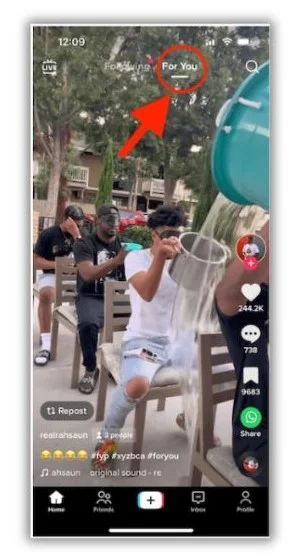
Everyone’s For You feed is unique and will change over time. TikTok pays attention to the videos you watch, where you post comments, and the accounts you follow. Each interaction is another signal the algorithm uses to refine your FYP—showing videos you’ll probably like while keeping videos you won’t off your feed.
💡 Want to grow all of your marketing channels? Download The Best Online Marketing Tips for Generating More Traffic, Leads, & Sales to get over 100 actionable growth marketing tactics.
How does the TikTok Algorithm work in 2024?
If you’ve ever sent your friend a cake recipe link because you remembered they love to bake, you get the gist of how the TikTok algorithm works.
Of course, TikTok’s proprietary algorithm is infinitely more complex than yours (no insult intended). It analyzes thousands of signals to determine which videos belong on your FYP. Let’s look at a few of the most influential ranking factors.
Factors TikTok uses to rank content
We’ll probably never know what every TikTok ranking factor is, but thanks to this post from TikTok itself, we do have an idea of a few ranking categories.
User interactions
Your behavior in the TikTok app is the most influential signal for the algorithm. Whenever you like a video or follow a particular account, TikTok uses that to understand your preferences further.
These are some of the user interaction signals TikTok will track:
- Watching full videos
- Following or hiding accounts
- Liking or sharing videos
- Commenting
- Reporting a video as inappropriate
- Adding videos to favorites
TikTok also uses what you say you are and aren’t interested in when you first join the app to guide its suggestions.
Other users’ interactions on a video can also determine whether you get it on your feed. If many people who share your interests watch and like a post, there’s a bigger chance you’ll see it, too.
Video information
On the flip side of the equation, TikTok reviews certain characteristics of the videos you’ve interacted with to see how they match your preferences. That’s important for creators to know since these are the things we have the most control over.
Here are a few of the video and post characteristics the algorithm looks for:
I’ll go into how to optimize your videos for TikTok marketing using these characteristics in a bit.
Device and settings
Device and settings are also user-specific actions the algorithm uses to recommend content. If you’re registered as a US user, you’ll see a lot more content made in the USA. But unlike user interactions, these are one-time signals that don’t typically change over time.
A few device and setting signals that may nudge the TikTok algorithm include:
- Language setting
- Country setting
- Device type
TikTok factor weighting
TikTok’s algorithm weights ranking factors based on how directly they indicate viewer preferences. Direct user actions, like watching a full video, carry much more influence than geographic location.
This means that while it’s good to be aware of all the ranking factors, your focus should be on posting content that your audience will want to watch and share.
Factors that don’t help (and could hurt) your content ranking
In its post, TikTok says it won’t give creators a boost based on past performance. Someone with a high follower count and previously viral videos won’t get preferential rankings over a smaller account with more relevant content.
Additionally, there are some types of content that TikTok will de-rank (show less or not at all) in your FYP. These include:
- Videos you’ve already seen
- Content that’s considered spam
- Duplicated content (like a second post of the same video)
- Videos with restricted content (like graphic medical procedures)
To be clear, some of this content will still be available if you search for it. It just won’t pop on your FYP.
How to reset the TikTok algorithm
TikTok’s algorithm finds the type of content you’ll love based mainly on what you’ve enjoyed in the past. Sometimes, the recommendations don’t keep up with your changing preferences, and your feed gets stale.
TikTok has built a way for you to scrub its algorithm so it starts from scratch. Then, your interactions moving forward will influence the content you get on your personal FYP.
Here are the steps to refresh your FYP:
- Open the TikTok app and tap “Profile”
- Go to the menu at the top and choose “Settings and privacy”
- Tap “Content preferences”
- Tap “Refresh your For You feed”
- Tap “Continue” and “Continue” again
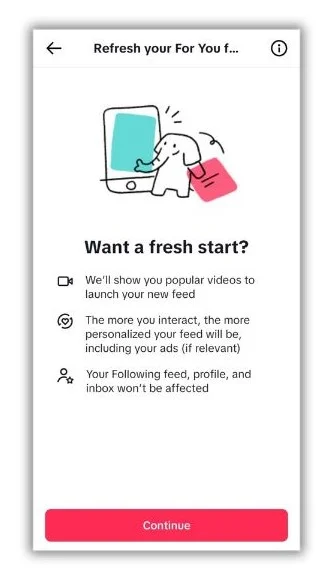

You can’t go back once you finish the process. But only your FYP will be affected. Your “Following” feed and profile won’t change.
📣 Free guide >>> 135 of the Best Words & Phrases for Marketing With Emotion
9 ways to use the TikTok algorithm to your advantage
Knowing how the TikTok algorithm works is half the battle. The other half is publishing engaging content that makes it easy for TikTok to find, categorize, and suggest your posts.
1. Hook viewers quickly
You have a fleeting second or two to grab a viewer’s attention and convince them to watch your video. Keep their thumbs from scrolling by adding an attention-grabbing hook that’s relevant to your audience.
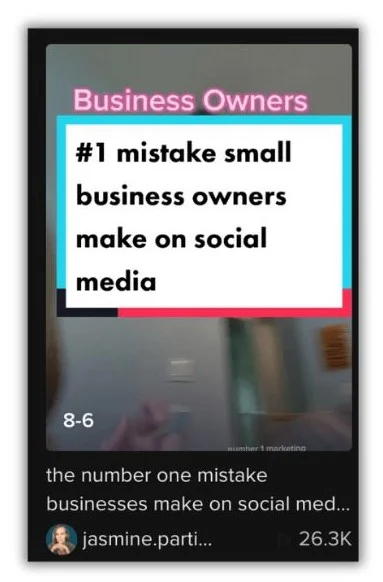

A great hook should give the viewer just enough information to make them want more. Try these tactics for your video hooks:
- Make a bold claim
- Ask a question
- Share a surprising fact
- Hint at a secret
Make sure each hook is relevant to your audience, and use emotional words to catch their attention.
2. Create niche content
It’s hard to gain footing with very popular topics on TikTok since many creators are already fighting for precious FYP placement. However, you can use the algorithm to your benefit by finding niche topics to post about.
For example, cooking is a super popular topic on TikTok. There are plenty of accounts dedicated to whipping up the best dishes. But Bobby Hicks of @theretrorecipekitchen uses his account to trial dishes from days of old. Many of the recipes he tests look tasty, while others look like…a veggie gelatin stack?


It may seem a little odd, but by focusing on one corner of a popular topic, Hicks has grown his account to over 150k followers.
Review the topics you’d like to use, and if they seem a little crowded, find a subtopic your audience would appreciate. That’ll leave you with fewer competitors in the race for the FYP. It’ll also make your content more relevant to a specific audience, which the algorithm loves.
3. Use TikTok SEO
Search engine optimization isn’t just for Google. Pretty much any time there’s a search function, you can optimize your content for it, and TikTok is no exception. Plus, even Google admits that TikTok is becoming a popular search engine in its own right.
In addition to the other tips in this guide, you’ll want to use keyword research to boost your TikTok SEO. Like on search engines, people use specific words and phrases in the search bar to find content on the app. Your job is to figure out what those words are.
Keyword research is easy on TikTok. Make a list of things your audience might search for that are relevant to your business. If you’re an esthetician, “skin care” might be one of them. Then, enter those words into the TikTok search bar and see what it auto-fills.
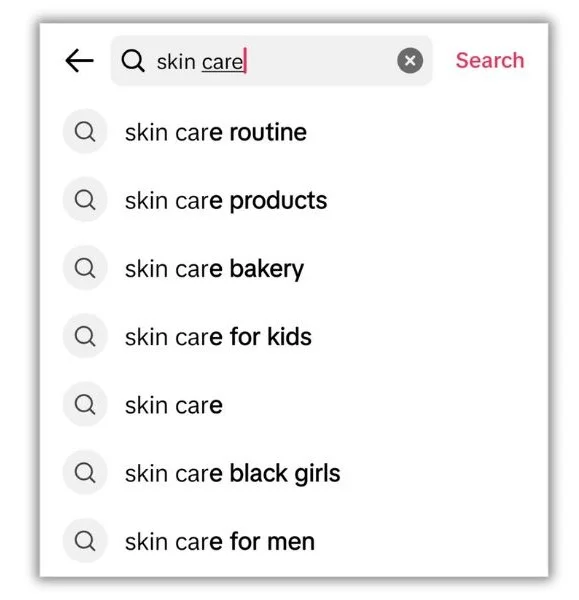

You’ll see options like “skin care for men” and “skin care routine.” Once you’ve gathered a list of keywords, plan out your content calendar to cover each term. Don’t forget to add keywords to your TikTok bio, too.
4. Tailor content to the platform
It’s smart to repurpose content for multiple platforms. But when it’s time to post it on TikTok, make sure it fits the app’s best practices.
First, produce and edit full-screen, vertical videos with a 9:16 ratio. That will fill the entire mobile screen while matching how most people view TikTok content.
Second, keep most of your videos short. While there’s no ideal duration for every video, in 2021, TikTok suggested that the optimal length should be 24 to 31 seconds. The platform has pushed for longer content, but many viewers find videos longer than one minute to be stressful, so it’s safer to keep them under 60 seconds.
Finally, for the best chance of your TikTok videos going viral, keep them positive in tone. Semrush evaluated a large collection of viral TikTok videos and found that those with a positive, funny, or happy vibe did best.
Follow these best practices to get more early engagement, which the algorithm will use as a signal that your video belongs on more FYPs.
5. Post at the right time and frequency
The TikTok algorithm doesn’t really care what time or how often you post—at least not directly. But it does look at how much engagement an individual video gets. Knowing when and how frequently to post can give your videos a little engagement boost.
The right time
The best time to post on TikTok depends on when most of your audience will be on the app. The goal is to publish content a little before the peak potential viewing time to get them indexed and ready for your followers.
You can find that information in your TikTok analytics.
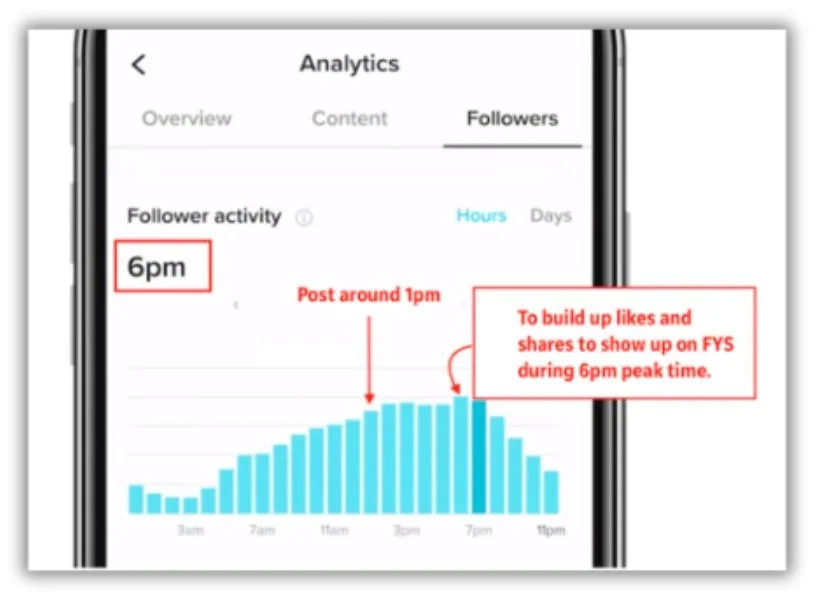

The right frequency
Consistency is essential for success on any social media platform. You don’t want followers to forget about you, and you want more chances to reach new viewers. But how do you quantify “consistency?”
Just like timing, learning how often you should post on TikTok will take some trial and error. TikTok says you should post up to four times per day (of course they do). More realistically, most brands post content to TikTok around two to four times per week (depending on which study you follow).
Here are a few tips to find your perfect TikTok schedule:
- Consider your creative capacity: Posting more often is great, but not at the expense of quality.
- Review other creators: Spy on your competition to see how often successful accounts in your niche post content.
- Watch your analytics: Vary your posting frequency over several weeks and see how it affects your views and engagement.
6. Incorporate hashtags
Using hashtags on TikTok can help you succeed in two ways. First, hashtags help the TikTok algorithm understand your content so it can better match it to user preferences.
Second, TikTok users use hashtags to search for content, so when your video is tagged, it may show up in their search. As we know, when more people see your content, the algorithm will show it to more people with similar interests.
You can find which hashtags are trending in TikTok’s Creative Center.
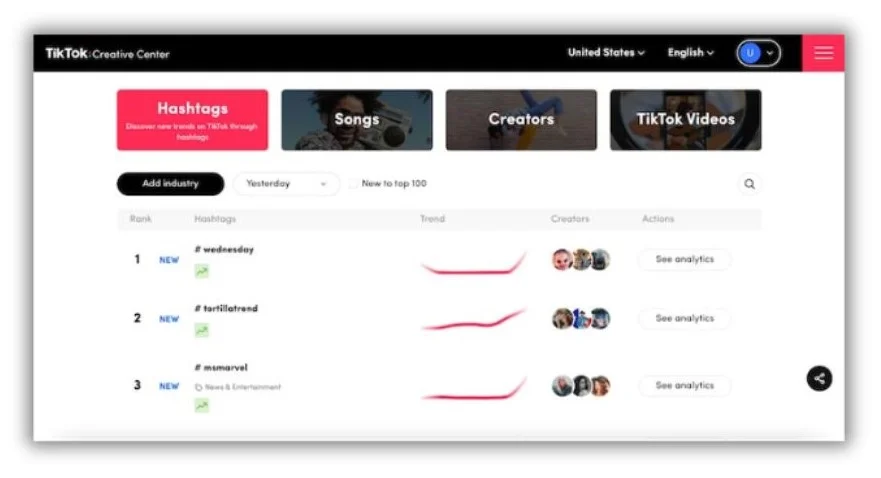

Here are a few tips for using hashtags on TikTok:
- Don’t use too many: One to four hashtags will usually do the trick without making your post look spammy.
- Use different types: Combine branded, topical, popular, and niche hashtags for the best mix of reach and relevance.
- Include seasonal and holiday hashtags: Adding seasonal hashtags like #hellospring and #Holloweenscares lets you ride the wave of attention during peak times of the year.
7. Add popular audio clips
Audio clips work similarly to hashtags on TikTok. If an audio clip gets popular, and you like videos that use that clip, there’s a greater chance you’ll get more videos with that audio in your FYP.
Head back to the Creative Center to find trending songs.
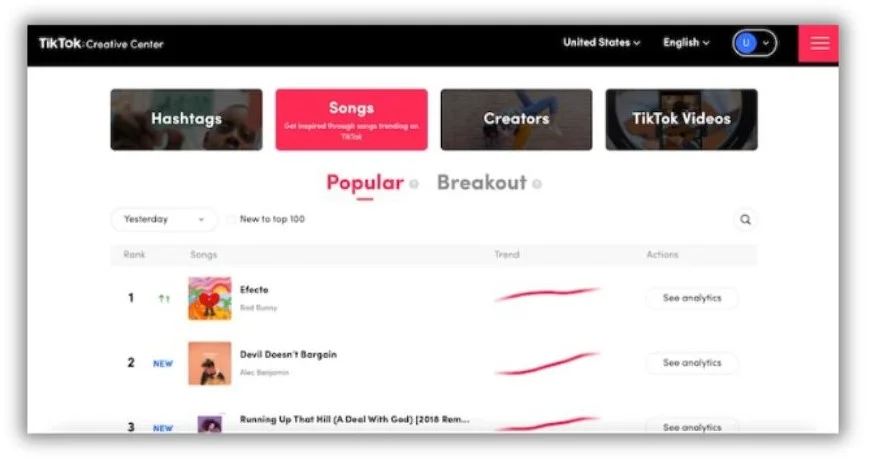

Look in the Popular tab to see which tunes are already getting a lot of play. Then, check out the Breakout tab to catch the next audio wave early.
8. Add captions
Many people don’t watch videos with the sound on. Adding captions to your posts lets those people follow along. But captions don’t just help you appeal to a broader audience. TikTok’s algorithm can learn more about your videos from the text of its caption.
TikTok makes it easy to add captions. Tap the Captions icon, and the app will automatically generate them.


Make sure you use the keywords you dug up in your video script. The algorithm will read those in the captions and know who should see your videos.
9. Jump on trends
One of the best ways to leverage the algorithm to get views is by following TikTok trends. A trend is a theme, idea, or trait of a video that already has mass appeal. That might be a common song or a dance.
Trends can also be challenges, like this one where one person holds another so they look like they’re in the iconic scene from the movie Titanic.
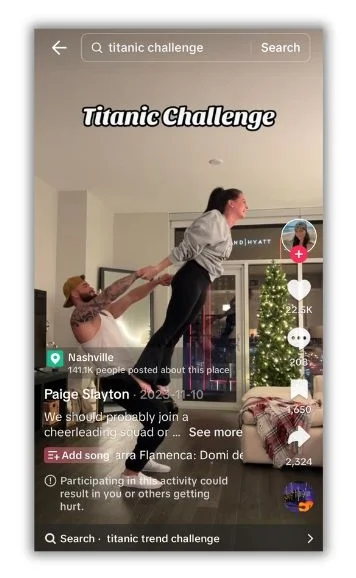

When viewers get hooked on a trend, TikTok sends them more videos to view. If you’ve jumped on the trend, the algorithm will put your video in that mix.
Work with the TikTok algorithm to go viral
The trick to social media marketing is remembering that social platforms want you to succeed. If people love the content you post, they’ll spend more time on the app—which is a win-win for everyone.
The key is learning how the TikTok algorithm works to make it your partner in success. Instead of fighting against the algorithm, find ways to leverage it, and you’ll leap-frog ahead of all the accounts trying to trick or hack it.
Here’s a recap of nine ways you can use TikTok’s algorithm to your advantage:
- Hook viewers quickly
- Create niche content
- Use TikTok SEO
- Tailor content to the platform
- Post at the right time and frequency
- Incorporate hashtags
- Add popular audio clips
- Add captions
- Jump on trends
-

 MARKETING7 days ago
MARKETING7 days agoThe key to correcting the C-suite trust deficit
-

 MARKETING6 days ago
MARKETING6 days agoA Recap of Everything Marketers & Advertisers Need to Know
-

 PPC4 days ago
PPC4 days agoHow the TikTok Algorithm Works in 2024 (+9 Ways to Go Viral)
-

 MARKETING4 days ago
MARKETING4 days agoHow To Protect Your People and Brand
-

 SEARCHENGINES5 days ago
SEARCHENGINES5 days agoGoogle Started Enforcing The Site Reputation Abuse Policy
-

 SEO7 days ago
SEO7 days ago128 Top SEO Tools That Are 100% Free
-

 SEO5 days ago
SEO5 days agoBlog Post Checklist: Check All Prior to Hitting “Publish”
-

 PPC5 days ago
PPC5 days agoHow to Craft Compelling Google Ads for eCommerce















